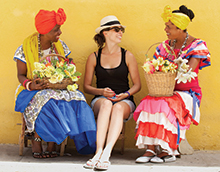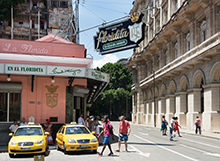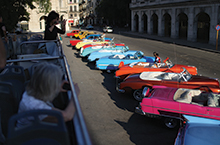Yanquis in Havana
Finance & Development, September 2015, Vol. 52, No. 3
The thaw in relations between the United States and Cuba could lead to a big shake-up in Caribbean tourism

It’s not clear how many Americans have dreamed of strolling through Havana as Ernest Hemingway once did, sipping Cuba libres or daiquiris and driving a vintage car to Finca La Vigia, Hemingway’s home outside of town. But the world may be about to find out.
The rapprochement between the United States and Cuba could lead to the full removal of travel restrictions between the two countries, and—given the colorful, tumultuous history between them—liberalization could open a floodgate of visits from U.S. baby boomers, thirsty for a glimpse of the Havana so cherished by the Nobel Prize–winning U.S. author.
The impact of removing all barriers to U.S.–Cuba travel is uncertain, but it is the focus of much interest in the region. Tourism is the main driver of growth and employment in many of the island countries in the Caribbean, where Cuba is a giant, not only in land size but as a tourist destination too. After Cancún in Mexico and the Dominican Republic, Cuba is the third largest destination for tourists in the Caribbean. Cuba had more than 3 million visitors in 2014, according to the Caribbean Hotel and Tourism Association, a 5.3 percent increase over 2013. Most of them came from Canada, Europe, and South America.
Close to home
A major question is what will happen when the market with the greatest number of tourists in the region is opened to a large potential supplier of tourist attractions—and compared with most destinations, one that is a stone’s throw from the United States.

The United States already does business with Cuba, in particular exporting foodstuffs and medical products for cash (since 2000). And after the United States eased the travel ban on its citizens traveling to Cuba (for specific purposes) in 2012, the number of U.S. tourists headed there rose by 33 percent almost immediately, to about 98,000. But that number probably pales in comparison with the number if travel restrictions were ended.
Can Cuba absorb a sudden surge in tourists? The country has a complex system of parallel currencies—the peso for Cubans, a convertible peso for tourists, and multiple other exchange rates. This alone renders international comparisons about things like market size or production capacity difficult. However, the Association for the Study of the Cuban Economy, based in the United States, estimates that capital formation has fallen sharply over the past two decades and economic growth has slowed in recent years. It seems likely that, in the short run at least, Cuba will not have the capacity to host many more tourists than it does now because it will take time to grow the number of hotel beds and supporting infrastructure.

There has been little empirical research on this topic, and most of what has been done focuses on the near term, which has tourism infrastructure constraints. During this period, lifting travel bans for U.S. citizens will give U.S. consumers a relatively cheaper beach travel option, creating a higher demand for tourism in Cuba that could raise prices there, all else equal. How this will play out depends on many factors, including what happens with the millions of tourists who now vacation in Cuba.
Economist Rafael Romeu, who has assessed the possible impact on the Caribbean of liberalization of U.S. travel to Cuba, says that current U.S. travel restrictions have effectively acted as trade protection for the rest of the Caribbean—particularly Puerto Rico and the U.S. Virgin Islands—because of their open borders with the mainland. Romeu, a former IMF economist, uses an economic model that captures the U.S.–Cuba restrictions and also controls for natural disasters and other factors. The so-called gravity model Romeu uses estimates the specific costs to U.S. tourists caused by the bilateral restriction in terms of nautical miles and finds that the total cost for Americans visiting Cuba is the equivalent of going to the South Pacific, or even Antarctica, for a holiday (see box). This suggests that distant tourist destinations may have received more U.S. visitors than they would have without U.S. restrictions on Cuban travel.
A look at the model
Gravity trade theory accounts for the amount of trade or tourism between countries on the basis of the size of the country and its trade costs. Commonly the model uses the geographic distance between countries as a proxy for the costs of trade. Rafael Romeu models a counterfactual situation that isolates the effect of the bilateral tourism restrictions between the United States and Cuba, then controls for their removal. The model’s estimations control for distance, language, income, trade agreements, and other things—like market concentration. Romeu estimates that the restrictions raise the cost of travel for a U.S. tourist beyond what someone from Asia would pay to go to Cuba. Removing the barrier would be equivalent to a sharp drop in the cost of travel between the United States and Cuba.
Not zero sum
Lifting restrictions would raise the purchasing power of U.S. consumers in the short term. In this sense, Romeu’s original model found that opening Cuba to U.S. travelers would increase the total number of tourists visiting the Caribbean by between 4 and 10 percent (Romeu, 2008). So policymakers in other Caribbean islands need not despair. Growth in U.S. tourism to Cuba will not necessarily mean an equivalent reduction in visitors to other points in the Caribbean. In other words, it need not be a zero sum game. Moreover, there are a large number of potential new Caribbean tourists from places like Canada.
That does not mean that change would come without dislocation. It probably would involve redistribution—the so-called substitution effect. An influx of U.S. tourists with relatively higher purchasing power would quickly fill Cuba’s hotels, outbidding and displacing traditional tourists. At least some of the sunseekers displaced from Cuba would likely go to other islands in the Caribbean, including those abandoned by the U.S. tourists. Which of those islands wins or loses is harder to parse.
Romeu predicts that destinations that are culturally different from the United States would fare better. In other words destinations where a share of visitors now come from non-U.S. markets—such as the Dominican Republic, Guadeloupe, and Barbados—would be better positioned to pick up tourists displaced by Americans going to Cuba. Places that today are heavily dependent on the United States—such as the U.S. Virgin Islands, Aruba, The Bahamas, and Cancún—could lose U.S. tourists to Cuba. The net effect would depend also on how many U.S. visitors who were not previously Caribbean vacationers Cuba would attract.
IMF researchers (Laframboise and others, 2014) confirmed findings in the literature that tourism arrivals and expenditures are sensitive to price and income effects, and are particularly sensitive to unemployment in the markets that supply the tourists. They also found that arrivals in higher-end destinations were not sensitive to price factors (including the impact of the exchange rate). These sensitivities—elasticities in economist-speak—could also play a role in determining where in the Caribbean displaced Cuban travelers end up.
Timing is important
Romeu recommends that Caribbean destinations move to expand their customer base before any opening between Cuba and the United States. Timing is important because capturing tourists dislocated by the influx of Americans into Cuba could offset some losses and secure a share of the growing tourism pie. Romeu also recommends other steps, such as specializing in and delivering customized services to clients, based on noneconomic features like culture and language; increasing airline competition; and guarding against increasing costs, particularly tourist visa requirements aimed at U.S. visitors.
Indeed, consideration of the importance of price to most travelers points to an ongoing need to contain costs, and for less-cost-sensitive high-end destinations to ensure that product and service quality remain consistent with their premium brand.
Because Cuba still appears amazingly as it was in the 1950s, more Americans could soon see it just as the iconic, hard-drinking Hemingway did. This time-capsule effect could be a key drawing card for nostalgic retirees who want to hang out at the El Floridita bar, the birthplace of the daiquiri and Hemingway’s favorite watering hole (where his alleged record of drinking 15 extra-cold sugarless daiquiris in one sitting took place). The opening of Cuba to U.S. travelers could bring a major upheaval in Caribbean tourism, but if countries prepare and invest, the gains from trade need not necessarily come at their neighbors’ expense. However, time may be of the essence. The charm of a midcentury Cuba won’t last long once this unique market expands and modernizes to accommodate the arrival of American tourists. ■
References
Laframboise, Nicole, Nkunde Mwase, Joonkyu Park, and Yingke Zhou, 2014, “Revisiting Tourism Flows to the Caribbean: What Is Driving Arrivals?” IMF Working Paper 14/229 (Washington: International Monetary Fund).
Romeu, Rafael, 2008, “Vacation Over: Implications for the Caribbean of Opening U.S.–Cuba Tourism,” IMF Working Paper 08/162 (Washington: International Monetary Fund).


